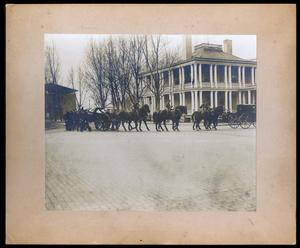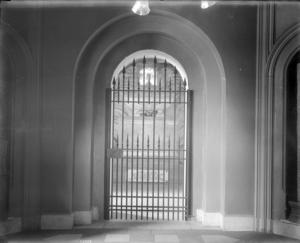 On this day in 1829, James Smithson passed away in Genoa, Italy. His remains were originally buried there, about a mile west of Genoa, on a high elevation overlooking the town of Sampierdarena. In January 1904, Alexander Graham Bell headed the team that brought back Smithson's remains to the United States.
On this day in 1829, James Smithson passed away in Genoa, Italy. His remains were originally buried there, about a mile west of Genoa, on a high elevation overlooking the town of Sampierdarena. In January 1904, Alexander Graham Bell headed the team that brought back Smithson's remains to the United States.
A simple mortuary chapel was created in a room to the left of the north entrance of the Smithsonian Institution Building by the Washington architectural firm of Hornblower & Marshall. Within the chapel there were stained-glass windows, a plaster ceiling, and a floor of dark Tennessee marble. The entrance to the room was sealed off by a heavy iron gate created from pieces of the fence that had surrounded the Italian grave site.

In 1974 the crypt room was renovated and the gates removed so that people could now enter the room to see the crypt of James Smithson. During the renovation, Smithson's coffin was removed from the tomb and scientific study conducted on Smithson's skeleton by Dr. J. Lawrence Angel, Curator of Physical Anthropology, National Museum of Natural History. Among their various findings, Dr. Angel determined that Smithson was 5 feet 6 inches tall; that he died of natural causes; that he had an extra vertebrae; that he smoked a pipe; and that he was probably an avid fencer based upon the development of his shoulders. After a 48-hour period, his remains were resealed in the coffin and replaced in the tomb.
Smithson's gift to the United States lead to the founding of the Smithsonian Institution we see today, with its 19 museums, the National Zoo, and multiple research centers. With its collections numbering 137 million, and with 30 million visitors per year, the Smithsonian strives to continue its mission towards the "increase and diffusion of knowledge."
Related Resources
Mr. Smithson Goes to Washington And the Search for a Proper Memorial, The Smithsonian’s Architectural History & Historic Preservation Division
Fun Facts: The Surprises You Find When Writing Wikipedia With the Archives, The Bigger Picture blog, Smithsonian Institution Archives
Produced by the Smithsonian Institution Archives. For copyright questions, please see the Terms of Use.

Leave a Comment